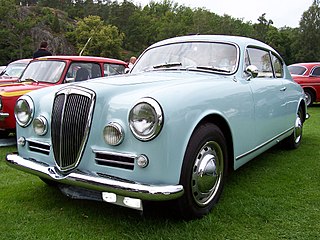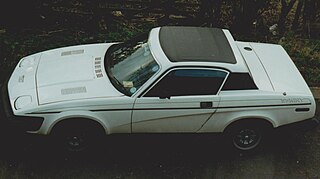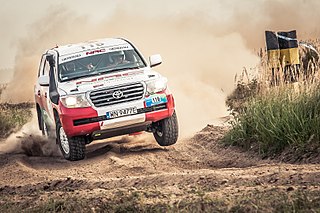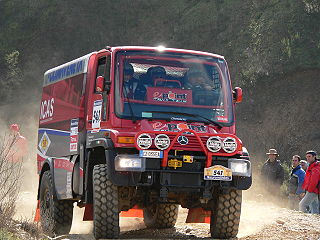
The Ford GT40 is a high-performance endurance racing car designed and built by the Ford Motor Company. It grew out of the "Ford GT" project, an effort to compete in European long-distance sports car races, against Ferrari, who had won the prestigious 24 Hours of Le Mans race from 1960 to 1965. Ford succeeded with the GT40, winning the 1966 through 1969 races.

Sports car racing is a form of motorsport road racing which utilises sports cars that have two seats and enclosed wheels. They may be purpose-built prototypes or grand tourers based on road-going models. Sports car racing is one of the main types of circuit auto racing, alongside open-wheel racing, touring car racing and stock car racing. Sports car races are often, though not always, endurance races that are run over particularly long distances or large amounts of time, resulting in a larger emphasis on the reliability and efficiency of the car and its drivers as opposed to outright car performance or driver skills. The FIA World Endurance Championship is an example of one of the best known sports car racing series.

A grand tourer (GT) is a type of car that is designed for high speed and long-distance driving, due to a combination of performance and luxury attributes. The most common format is a front-engine, rear-wheel-drive two-door coupé with either a two-seat or a 2+2 arrangement. Grand tourers are most often the coupé derivative of luxury saloons or sedans. Many iconic car models, such as the Ferrari 250 GT, Jaguar E-Type, and Aston Martin DB5, are considered classic examples of Gran Turismo cars.

The Triumph TR8, eight-cylinder version of the "wedge-shaped" Triumph TR7 sports car was designed by Harris Mann and manufactured by British Leyland (BL), through its Jaguar/Rover/Triumph (JRT) division. Because of its outstanding performance, the TR8 was often dubbed the "English Corvette". The majority of TR8s were sold in the United States and Canada.

Group B was a set of regulations for grand touring (GT) vehicles used in sports car racing and rallying introduced in 1982 by the Fédération Internationale de l'Automobile (FIA). Although permitted to enter a GT class of the World Sportscar Championship alongside the more popular racing prototypes of Group C, Group B are commonly associated with the international rallying scene during 1982 to 1986 in popular culture, when they were the highest class used across rallying, including the World Rally Championship, regional and national championships.

The Triumph TR7 is a sports car manufactured in the United Kingdom from September 1974 to October 1981 by British Leyland Motor Corporation (BLMC), which changed its name to British Leyland (BL) in 1975. The car was launched in the United States in January 1975, with its UK home market debut in May 1976. The UK launch was delayed at least twice because of high demand for the vehicle in the US, with final sales of new TR7s continuing into 1982.

The World Sportscar Championship was the world series run for sports car racing by the FIA from 1953 to 1992.

The Lola T70 is a sports prototype developed by British manufacturer Lola Cars in 1965. Lola built the aluminium monocoque chassis, which were typically powered by large American V8s.

The 1966 24 Hours of Le Mans was the 34th Grand Prix of Endurance, and took place on 18 and 19 June 1966. It was also the seventh round of the 1966 World Sportscar Championship season. This was the first overall win at Le Mans for the Ford GT40 as well as the first win for an American constructor in a major European race since Jimmy Murphy's triumph with Duesenberg at the 1921 French Grand Prix. It was also the debut Le Mans start for two significant drivers: Henri Pescarolo, who went on to set the record for the most starts at Le Mans; and Jacky Ickx, whose record of six Le Mans victories stood until beaten by Tom Kristensen in 2005.
Group 5 was an FIA motor racing classification which was applied to four distinct categories during the years 1966 to 1982. Initially Group 5 regulations defined a Special Touring Car category and from 1970 to 1971 the classification was applied to limited production Sports Cars restricted to 5 litre engine capacity. The Group 5 Sports Car category was redefined in 1972 to exclude the minimum production requirement and limit engine capacity to 3 litres. From 1976 to 1982 Group 5 was for Special Production Cars, a liberal silhouette formula based on homologated production vehicles.
The 1969 World Sportscar Championship season was the 17th season of FIA World Sportscar Championship motor racing. It featured the 1969 International Championship for Makes, which was a series for FIA Group 6 Prototype Sports Cars, Group 4 Sports Cars and Group 3 Grand Touring Cars and the 1969 International Cup for GT Cars, which was restricted to Group 3 Grand Touring Cars. The season ran from 1 February 1969 to 10 August 1969 and comprised 10 races.

The Group 3 racing class referred to a set of regulations for Grand Touring Cars competing in sportscar racing and rallying events regulated by the FIA. These regulations were active, in various forms, from 1957 to 1981.

The Group 2 racing class referred to regulations for cars in touring car racing and rallying, as regulated by the FIA. Group 2 was replaced by Group A in 1982.
Group 7 was a set of regulations for automobile racing created by the Commission Sportive Internationale (CSI), a division of the modern Fédération Internationale de l'Automobile.

The Triumph TR7 Sprint version of the Triumph TR7 sports car was produced in 1977 by the Triumph Motor Company then part of British Leyland. However, it was produced in only very limited numbers: Probably a maximum of 61 in total were manufactured. It used the 127 bhp, 16-valve, 2-litre version of the Triumph slant-four engine from the Triumph Dolomite Sprint, a highly tuned version of which, "rated at 225 bhp at 8000 rpm" by 1977, was used in the Group 4 TR7 cars of the BL works rally team, from 1976 until 1978. This was instead of the TR7 base model's 105 bhp, 8-valve, 2-litre version of the same basic slant-4 engine. The 16-valve version was originally specified in the Dolomite Sprint at 135 bhp, and "Spenser King relates how he went away on holiday and came back to find an engine running on the bed giving 150 bhp at the first build."

Group GT3, known technically as Cup Grand Touring Cars and commonly referred to as simply GT3, is a set of regulations maintained by the Fédération Internationale de l'Automobile (FIA) for grand tourer racing cars designed for use in various auto racing series throughout the world. The GT3 category was initially created in 2005 by the SRO Group as a third rung in the ladder of grand touring motorsport, below the Group GT1 and Group GT2 categories which were utilized in the SRO's FIA GT Championship, and launched its own series in 2006 called the FIA GT3 European Championship. Since then, Group GT3 has expanded to become the de facto category for many national and international grand touring series, although some series modify the ruleset from the FIA standard. By 2013, nearly 20 automobile manufacturers have built or been represented with GT3 machines.

Grand Touring Endurance, shortened to GTE, is a set of regulations maintained by the Automobile Club de l'Ouest (ACO) and IMSA for grand tourer racing cars used in the 24 Hours of Le Mans, 24 hours of Daytona GTLM, and its associated series. The class was formerly known as simply Group GT between 1999 and 2004, and later referred to as Group GT2 between 2005 and 2011. The GT2 name has since been revived for a different set of regulations.

The Group N-GT was a motor racing category launched by the Fédération Internationale de l'Automobile in 2000. The first cars were homologated on 1 March, 2000 by Porsche and Ferrari. A total of eight different models from six marques were homologated throughout the class existence.

In relation to motorsport, Group T2 is a set of technical specifications for series production cross-country cars used in off-road Cross-Country Rallying. The group is governed by the Fédération Internationale de l'Automobile (FIA) and defined in appendix J, article 284 of its International Sporting Code. The cars must use a bodyshell and apart from safety features such as a roll cage and upgraded suspension and wheels, must retain features of the series production car unlike the thoroughbred race prototypes in Group T1, which have more freedom surrounding the chassis build and other parts. The cars in T2 must be homologated with a series production build requirement of 1000 identical units.

In relation to motorsport, Group T5 is a set of technical specifications for prototype cross-country trucks used in off-road Cross-Country Rallying. The group is governed by the Fédération Internationale de l'Automobile (FIA) and defined in appendix J, article 287 of its International Sporting Code.



























